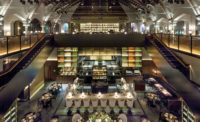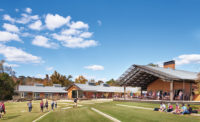Winston-Salem, North Carolina
Cigarettes built Winston-Salem, North Carolina, just as much as bricks and mortar. By 1916, four decades after an entrepreneurial 20-something named R. J. Reynolds established a tobacco venture there, his company imported so much Turkish tobacco and French rolling papers for its blended varieties that the city became the eighth-largest port of entry in the United Sates—despite being 200 miles inland.
The metropolis is still known as Camel City for its hit brand of smokes, though the cluster of factories that once produced them by the billions is now evolving into spaces for biotech startups, research institutions, and creative firms. TPG Architecture recently breathed fresh (and nicotine-free) air into the third floor of one of these 1920s-era buildings for the advertising agency MullenLowe. Rather than conceal what remained of the building’s gritty industrial past, the New York–based architects worked with its brawny, poured-in-place-concrete structure and peeling surfaces to foster a flexible and creative workplace for an office of 185 people—without the feel of the oft-replicated techie playground.
“A lot of the advertising firms I work for want to be the next Google, with different themed spaces and different colors,” says Carly Jacobson, the lead project designer. Jacobson, who also completed MullenLowe’s Boston office in 2009, continues, “This building had an overwhelming number of assets, so our approach was to make it feel as if we didn’t touch anything.”
To accomplish this, the architects inserted a series of three sleek, geometric volumes within the existing structure. This “box within a box” scheme breaks down the L-shaped, 37,500-square-foot floor office by creating spaces for meetings, while still maintaining open, non-hierarchical work areas.
From a glazed atrium, visitors enter a reception area at the crook of the L. It is a cool respite from the Carolina humidity, all exposed concrete and subdued colors. Here, behind the reception desk, Jacobson and her team located the first box, a freestanding T-shaped volume containing a boardroom and three smaller meeting spaces. “They have these intersecting relationships, as if they are puncturing each other,” explains Jacobson, pointing to where an 11-foot, 6-inch-tall drywall volume collides with 10-foot-tall one clad in plywood. The boxes seem to have been slid into the space like ships into a bottle, allowing for just 1 foot of clearance between some of the columns and as little as 2½ feet below the ceiling slab.
Inside the main conference room, inviting finishes provide a counterbalance to the raw industrial surroundings: slate-colored walls are juxtaposed with white acoustical ceiling panels and tawny birch.Neutral-hued modern furnishings echo existing colors in the factory’s walls and columns. Glazed openings in the boxes allow views directly to the factory’s new perimeter windows, while a hefty 10-foot-tall sliding panel opens the boardroom to the reception area for company meetings and celebrations.
The boxes also solve another challenge: how to unify the creative and business sides of the agency. MullenLowe Winston-Salem president Taylor Bryant says ruefully, “Agencies are composed of diverse people—and those people are not necessarily drawn to work together.”
The placement of the independent containers creates natural neighborhoods for different disciplines. Open-plan workspaces with long rows of shared desks for employees on the business side surround another T-shaped set of conference rooms on the south end of the building. (“They sit here because it’s the more private space,” Jacobson explains.) The creative team abuts a smaller volume on the north side. This end of the office includes amenities that the company’s previous space—a converted bank—lacked, including a 30-person screening room with stadium seating, a photo studio, a sound booth, a printing room, and several editing suites. In these dedicated spaces, MullenLowe can seamlessly develop campaigns for clients ranging from Hanes to a local microbrewery.
Both ends of the office are punctuated by social spaces that include a coffee bar and lounge, a daylight-filled corner “town hall,” and a kitchen. The design team also placed high work tables (hemmed by perforated screens that cleverly double as pinup boards) near the windows to facilitate impromptu meetings and to allow staff members to have a change of scene from their desks.
“We felt the old space was sucking the energy out of people, because everyone was in their own little world,” says Bryant of the former office’s cubicle configuration. “Now you see three people have spun their chairs around. They wouldn’t necessarily call it a meeting, but they are sharing ideas.”
By Bryant’s metric, meetings abounded on a recent afternoon this summer: a group gathered in the lounge to play a round of pool, while others chatted over their microwaved lunches. A full-time barista (brought in from Krankies, a neighborhood coffee shop) made caffeinated beverages for a line of employees. Across the office in the printing room, an employee displayed a freshly inked poster for a staff Tiki party.
They are blissfully oblivious of the subtle particulars that went into creating their industrial-chic habitat. Jacobson and her team, for instance, carefully oriented ductwork over the conference room boxes and rows of desks to emphasize both the volume of the architectural insertions, and to create strong perspectival lines across the work floor. As a finishing touch, the painted concrete columns were lightly sandblasted and sealed to reveal nearly a century’s worth of chipped layers; the effect is something like an abstract expressionist painting. Even with the new additions and new program, the soul of the original Camel City factory still burns bright.
PeopleArchitect: TPG Architecture 31 Penn Plaza 132 W. 31st Street New York, NY 10001 212-768-0800 (t) 212-768-1597 (f) Personnel in architect's firm who should receive special credit: Larry Berger, RA – Studio Director Carly Jacobson, LEED AP – Senior / Lead Designer Megan Adams, LEED Green Associate - Designer Omar Bustamante – Project Manager Pablo Almeida – Project Professional Architect of record: TPG Architecture Interior designer: Carly Jacobson, LEED AP - TPG Architecture Engineers: Kibart, Inc. (MEP) Pippin Engineering, PLLC (Structural) Consultants: OneLux (Lighting) Spectra (Audio Visual) General contractor: Landmark Builders, 3520 Triad Court, Winston-Salem, NC 27107 Photographer: Eric Laignel – 917.204.4338 Size: 37,500 square feet Cost: withheld Completion date: January 2016
|
ProductsGlazing Glass: 1/2” Clear Tempered Glass on top and bottom black anodized aluminum channels. Doors (ALL DOORS were custom by CKS Architectural Millwork, based in Durham NC) Entrances: 3’-6”x10’-0”x1/2” Clear Tempered Herculite Door Metal doors: Hollow Metal Wood doors: 2-1/4” thick Solid Core Wood doors cladded with plywood panels to align with plywood cladded wall panels Sliding doors: Custom 12’0” wide x 10’0” high pocket doors at boardroom with custom full height blackened steel door pull set on heavy duty overhead door track. Fire-control doors, security grilles: Additional (2) entry doors are existing building 1-1/2 hour fire rated self-closing solid core wood doors. We provided (1) new 1-hour fire rated door for the spray room. No security grills required. Special doors: All Edit Room and Sound Booth doors were all fully sound attenuated doors with STC 52 sound rating. Hardware Locksets: FSB Locksets SML-I-1076-RA-0105-234-M4-*-214 Closers: LCN Overhead Door Closer Exit devices: No Panic Hardware was included in this project Pulls Rockwood 96” High x 1-1/4” Dia. back to back door pulls, Hafele for millwork Security devices: Magnetic Lock at glass entry door with Card Reader and Door Release button. Electric Strike at balance of entry doors and Card Reader. All doors tied to Building’s Class “E” System Other special hardware: Custom full height Blackened Steel door pulls for Boardroompocket doors. Interior Finishes Acoustical ceilings: Vogl Joint by Green Acoustics Building Products Cabinetwork and custom woodwork: done by CKS Architectural Millwork (based in Durham NC) Paints and stains: all paints were Benjamin Moore Wall coverings: Robin Reigi Tac Board Paneling: Plywood Paneling - Birch Grade A Plywood Plastic laminate: Wilsonarte, Formica Solid surfacing: Dupont Corian Special surfacing: Plywood Paneling - Birch Grade A Plywood Carpet: Interface Special interior finishes unique to this project: Custom perforated metal screens by Hive Mind Design (designed by TPG) – for pin up use and to provide separation between open meeting areas Furnishings Office furniture: Knoll Antenna for Benching Reception furniture: Herman Miller Scissor chair, DWR coffee table Fixed seating: Custom banquettes at the café, Stadium seating area – design by GC, fabricated by millwork sub Chairs: Herman Miller Eames Plastic Side Chair at café / meeting rooms, Herman Miller Eames Soft Pad Chair at reception, Aeron chair at workstations, reception chair listed above, Bernhardt design Osio chair at living rooms Tables: Prismatique conference tables, custom tables by Hive Mind Design at breakout areas, West Coast industry tables at Booths Upholstery: Maharam fabrics used everywhere, chilewich used for café banquettes Lighting Interior ambient lighting: See attached light fixture schedule (wills end this to you under separate cover) for Ambient Lighting Description for following fixture types: General Open Area Lighting - LT-01’s, LT-09’s, LT-08’s, LT-11, LT-13’s; Private Office / Meeting Rooms LT-02’s, LT-16 Downlights: LT-15’s, LT-19D & LT-20D Dimming system or other lighting controls: "Local on/off switch throughout and regular slide dimmers in Boardroom, Conference Rooms / War Rooms, Presentation Room, Edit Suites, Sound Booth. Other: Roll & Hill Rudi Loop 01 Pendant, Rich Brilliant Willing Branch Sconce |










